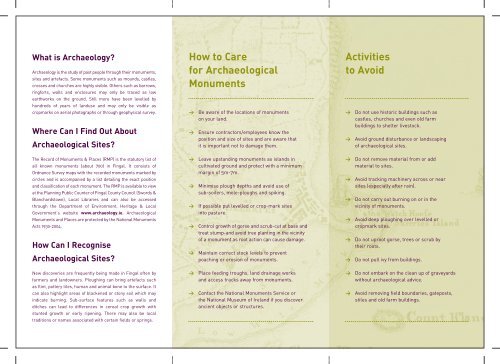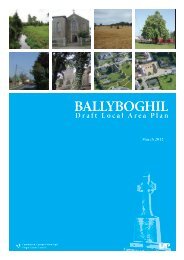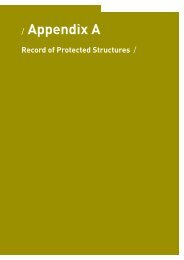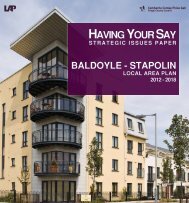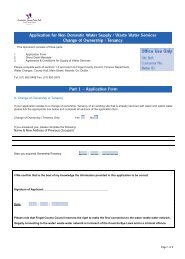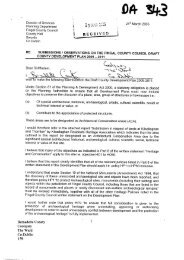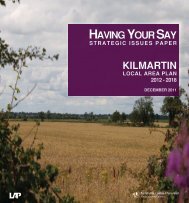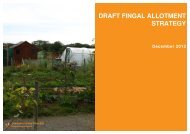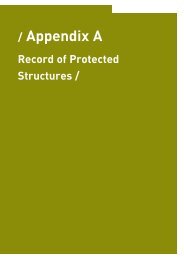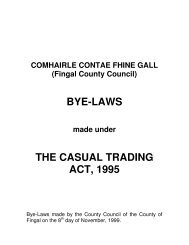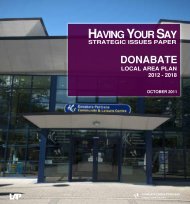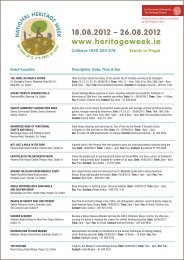Field Monument Advisor Leaflet - pdf - Fingal County Council
Field Monument Advisor Leaflet - pdf - Fingal County Council
Field Monument Advisor Leaflet - pdf - Fingal County Council
Create successful ePaper yourself
Turn your PDF publications into a flip-book with our unique Google optimized e-Paper software.
What is Archaeology?<br />
Archaeology is the study of past people through their monuments,<br />
sites and artefacts. Some monuments such as mounds, castles,<br />
crosses and churches are highly visible. Others such as barrows,<br />
ringforts, walls and enclosures may only be traced as low<br />
earthworks on the ground. Still more have been levelled by<br />
hundreds of years of landuse and may only be visible as<br />
cropmarks on aerial photographs or through geophysical survey.<br />
Where Can I Find Out About<br />
Archaeological Sites?<br />
The Record of <strong>Monument</strong>s & Places (RMP) is the statutory list of<br />
all known monuments (about 700) in <strong>Fingal</strong>. It consists of<br />
Ordnance Survey maps with the recorded monuments marked by<br />
circles and is accompanied by a list detailing the exact position<br />
and classification of each monument. The RMP is available to view<br />
at the Planning Public Counter of <strong>Fingal</strong> <strong>County</strong> <strong>Council</strong> (Swords &<br />
Blanchardstown), Local Libraries and can also be accessed<br />
through the Department of Environment, Heritage & Local<br />
Government’s website www.archaeology.ie. Archaeological<br />
<strong>Monument</strong>s and Places are protected by the National <strong>Monument</strong>s<br />
Acts 1930-2004.<br />
How Can I Recognise<br />
Archaeological Sites?<br />
New discoveries are frequently being made in <strong>Fingal</strong> often by<br />
farmers and landowners. Ploughing can bring artefacts such<br />
as flint, pottery tiles, human and animal bone to the surface. It<br />
can also highlight areas of blackened or stony soil which may<br />
indicate burning. Sub-surface features such as walls and<br />
ditches can lead to differences in cereal crop growth with<br />
stunted growth or early ripening. There may also be local<br />
traditions or names associated with certain fields or springs.<br />
How to Care<br />
for Archaeological<br />
<strong>Monument</strong>s<br />
> Be aware of the locations of monuments<br />
on your land.<br />
> Ensure contractors/employees know the<br />
position and size of sites and are aware that<br />
it is important not to damage them.<br />
> Leave upstanding monuments as islands in<br />
cultivated ground and protect with a minimum<br />
margin of 5m-7m.<br />
> Minimise plough depths and avoid use of<br />
sub-soilers, mole-ploughs and spiking.<br />
> If possible put levelled or crop-mark sites<br />
into pasture.<br />
> Control growth of gorse and scrub-cut at base and<br />
treat stump-and avoid tree planting in the vicinity<br />
of a monument as root action can cause damage.<br />
> Maintain correct stock levels to prevent<br />
poaching or erosion of monuments.<br />
> Place feeding troughs, land drainage works<br />
and access tracks away from monuments.<br />
> Contact the National <strong>Monument</strong>s Service or<br />
the National Museum of Ireland if you discover<br />
ancient objects or structures.<br />
Activities<br />
to Avoid<br />
> Do not use historic buildings such as<br />
castles, churches and even old farm<br />
buildings to shelter livestock.<br />
> Avoid ground disturbance or landscaping<br />
of archaeological sites.<br />
> Do not remove material from or add<br />
material to sites.<br />
> Avoid tracking machinery across or near<br />
sites (especially after rain).<br />
> Do not carry out burning on or in the<br />
vicinity of monuments.<br />
> Avoid deep ploughing over levelled or<br />
cropmark sites.<br />
> Do not uproot gorse, trees or scrub by<br />
their roots.<br />
> Do not pull ivy from buildings.<br />
> Do not embark on the clean up of graveyards<br />
without archaeological advice.<br />
> Avoid removing field boundaries, gateposts,<br />
stiles and old farm buildings.


